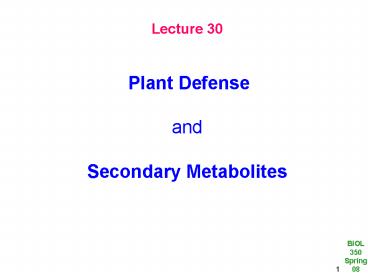Lecture 30 Plant Defense and Secondary Metabolites - PowerPoint PPT Presentation
1 / 22
Title:
Lecture 30 Plant Defense and Secondary Metabolites
Description:
Parasitic Cuscuta Plants. Runyon et al. 2006 Science 313 p. 1964. 17 ... Runyon et al. 2006 Science 313 p. 1964. Cuscuta uses volatile cues for host location ... – PowerPoint PPT presentation
Number of Views:1275
Avg rating:5.0/5.0
Title: Lecture 30 Plant Defense and Secondary Metabolites
1
Lecture 30 Plant Defense andSecondary
Metabolites
2
Plant Defense Responses
Passive (constitutive) defense
Active (inducible) defense
Cutin, waxes, suberin help reduce transpiration
and pathogen invasion
3
Structural Defence (passive)
4
Surface wax deposits form the top layer of the
cuticle
Brassica oleracea (cabbage)
5
Cutin, Waxes, and Suberin
Cutin
Wax
Suberin
6
Preformed Biochemical Defense
- Plants produce large and diverse array of
organic compounds - secondary metabolites that do not have
function in growth - and development
- Primary metabolites amino acids, sugars,
nucleotides, lipids ? - found throughout the plant kingdom
- Secondary metabolites found in only one plant
species or - related group of species Example
glucosinolates are only - present in Brassicaceae (cabbage, mustard,
Arabidopsis) - Secondary metabolites display antimicrobial
activity ? play - important role in plant defense
- - protection against herbivory and pathogens
- - attractants (smell, color, taste) for
pollinators, and seed- - dispersing animals
- - agents for plant-plant competition,
plant-microbe - symbioses
7
Three Groups of Secondary Metabolites
Limonoids Saponins Pinene
Flavonoids Anthocyanins Salicylic acid Lignin
Alkaloids Nicotine Morphine Cocaine Caffeine Gluco
sinolates
8
Secondary Metabolite Biosynthesis
9
The Terpenoids
Limonene Menthol
Clary Sage
Phytol Retinol (vitamin A)
Gibberellin
10
Monoterpenes serving as defenses against insects
11
Essential Oils are Stored in Surface Glands
Glandular hair of young leaf of spring sunflower
12
Two Triterpenes serving as insect feeding
deterrents
Neem Tree (Azadirachta indica), Africa, Asia
Fern (Polypodium vulgare)
13
Terpenes released form insect-attacked plants
attract natural enemies
Volatile terpenes released form the leaves of a
maize plant after attack of a lepidopteran larva
(and aphids) attract parasitic wasps that are
natural enemies of the lepidopteran larvae.
14
Parasitic Wasps
- - Females lay eggs singly in aphid nymphs
- - Wasp larvae consume aphids from inside
- As larvae mature and aphids are killed, aphids
turn into - mummies
- After larvae pupate, adult wasp emerge through
exit hole cut - in mummy
15
Volatiles guide host location and host selection
by parasitic plants (Cuscuta, dodder)
16
Parasitic Cuscuta Plants
Runyon et al. 2006 Science 313 p. 1964
17
Cuscuta uses volatile cues for host location
Cuscuta pentagona responds to terpenoids from
tomato, wheat and Impatiens C. pentagona could
distinguish between tomato and wheat volatiles
Grows preferably toward tomato
http//www.sciencemag.org.www.libproxy.wvu.edu/con
tent/vol313/issue5795/images/data/1964/DC1/1131371
_S1.mov
Runyon et al. 2006 Science 313 p. 1964
18
Nitrogen-containing secondary metabolites
Glucosinolates
- glucosinolates mustard oils - found in
Brassicaceae, the Cabbage family - are broken
down by the enzyme myrosinase to release
defensive substances
19
The Cabbage Family
20
Some important insect pests
Green peach aphid (Myzus persicae) feeding on
cabbage
Cabbage looper (Trichoplusia ni) feeding on
various crucifers
21
Myrosinase-Glucosinolate System
Myrosinase
Glucosinolates
22
Insect defense - The myrosinase-glucosinolate
system
Myrosinase (?-thioglucoside glucohydrolase) in
myrosin cells
Glucosinolates in vacuoles and sulfur-containing
cells (S-cells)
Herbivory
R side chain derived from Met, Trp, Phe
Myrosinase
H20
Glucose
R-NCS R-CN R-S-CN Isothiocyana
te Nitrile Thiocyanate

